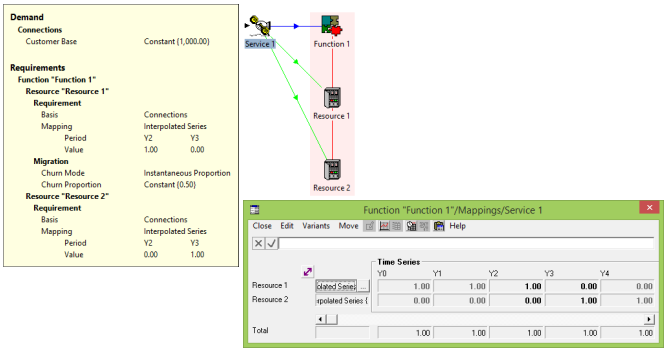Transition from Resource 1 to Resource 2
A simple example using Service 1 (Connections = 1000), and a function with Resources 1 and 2 (Capacity = 10 Subscribers, Physical Lifetime = 10 years) is shown. A transition from Resource 1 to Resource 2 is set in the function Mappings dialog, such that from Y3, any new demand will be carried by Resource 2.

Figure 1: Example model with transition of demand from Resource 1 to Resource 2 from Y3
If the Churn Proportion input were set to 0.5, then from Y3 onwards, 50% of demand would be transferred each year to Resource 2 if the model was running in years. STEM 7.5 behaves like earlier versions if you set the new input Churn Mode = Instantaneous Proportion.

Figure 2: Used Capacity of resources 1 and 2, and Installed and Used Units of resource 1
As the physical lifetime of the resources is 10 years, there would be many unused, and in this case redundant, units of Resource 1 once the transition from Resource 1 to Resource 2 starts in Y3.
Decommissioning of redundant units
You can determine how you want to decommission units of Resource 1 which are no longer required in the resource Advanced/Other Details dialog:
-
no decommissioning: leave Decommissioning Proportion as 0.0.
-
immediate decommissioning: set Decommissioning Proportion to 1.0 to decommission any units of Resource 1 straight away.
-
delayed decommissioning: decommission any redundant units after a specific time delay (e.g., define an interpolated series in which Decommissioning Proportion = 0.0 until end of Y5 and 1.0 from Y6 onwards).

Figure 3: Comparison of no decommissioning, immediate decommissioning and delayed decommissioning
In STEM 7.4, the Churn Proportion and Decommissioning Proportion inputs were interpreted as instantaneous proportions, which led to inconsistent results if a model was run in quarters or months instead of years. For example, if the input Churn Proportion = 0.5, then 50% of demand is transferred to Resource 2 each year after Y3 in the example above. However, if the Run Period is set in quarters or months, then 50% of demand is transferred to Resource 2 each quarter or month: that is, the results are different depending on whether the model is being run in years, quarters or months (shown below), which is clearly unsatisfactory.

Figure 4: Transition with Instantaneous Proportion in years, quarters or months
STEM 7.5 offers more explicit control over these transition and decommissioning trajectories, as well as a more satisfactory Annual Proportion interpretation by default, as explained in the following sections.